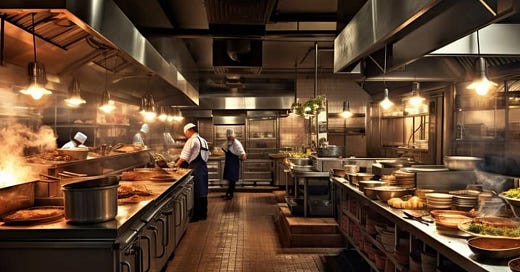(2/3) The Future of Food Service: Navigating the Shift to Digital Restaurants
The Architectural Shift in Culinary Services
Building on the digital transformation narrative introduced by the "discoverability" and "orderability" acts, we delve into the coming era that will fundamentally alter the restaurant industry's operational landscape. The advent of ghost kitchens marks a pivotal shift from physical dining experiences to a digitally integrated model of food delivery, dubbed the "scalability act." This evolution extends beyond the convenience of online ordering, promising to redefine the essence of what it means to be a restaurant. By abstracting physical infrastructure and significantly lowering barriers to entry, launching a digital restaurant now mirrors the simplicity of deploying a website. This part explores how the scalability act is shaping a new era of restaurant brand origination, where anyone can launch a digital restaurant, shifting the competitive landscape and signaling a deluge of digital brands onto delivery platforms.
Uniquely, interacting with the internet is universally accessible. Anyone with some coding skills, or even none at all (via website builders like Wix), can launch a site from the couch. Barriers to entry are slim to pushing information out into the world. Though not quite as simple as deploying code to a server, launching a digital restaurant is magnitudes simpler than standing up a physical store; Physical infrastructure is abstracted away.
Infrastructure abstraction lowers barriers to entry leading to a surge of restaurant brand origination. Launching a “restaurant” is reduced down to a three step process: develop a menu, deploy the menu to a Ghost Kitchen Network, and post the “restaurant” on delivery apps. Restaurant “founders” don’t have to ever cook the food or even try the food they are pushing out to customers. Written instructions are all that’s required. Just as “dot-coms” flooded the early internet, a stampede of digital brands onto delivery app platforms is the inevitable outcome.
The deluge’s already begun. UberEats’ digital brand volume quadrupled in the two years between 2021 and 2023 charging from ten to over forty thousand. For context, the delivery app hosts a total of nine-hundred-thousand restaurants. That means digital brands compose only about four percent of the total brand base and are the fastest growing segment on the platform. There’s a lot of room here.
Digital brands popping up so far on the app have thus far been primarily corporate offshoots. That’s to say that they’re owned and operated by “Digital Brand Partners” such as Virtual Dining Concepts. VDC operates the popular Mr.Beast Burger - a burger restaurant promoted by the YouTube megastar of the same name. Digital Brand Partners often run a portfolio of dozens of restaurants either built in-house or in collaboration with a public face or existing brand.
Today, distributing via a Ghost Kitchen Network requires some level of corporate or brand presence. Over the next few years, however, as overhead to launch continues to fall, so will the size of the entity required to do so. As of now, Kitopi, the Dubai based digital restaurant company mentioned a priori, operates up to seventy restaurants out of a single two thousand square foot kitchen. Each of these brands is an established global presence liscenced out for distribution to Kitopi.
Uber founder Travis Kalanick’s entry into the space Cloud Kitchens, on the other hand, offers a distributed kitchen as a service model providing restaurant brands with space for rent in commercial kitchens. Restaurants provide the staff, Cloud Kitchens the space. This is a different model to Kitopi and peers who staff and run their own kitchens. Kalanick’s approach is more of a real estate play, but the restaurants in his space are still “ghost kitchens”.
The “scalability act” opens the opportunity for merging the two models to create a true ghost kitchen network that's globally integrated, easily deployed too, and equipped to serve manifold cuisines. This new company would operate a network of kitchens that each have a capacity of hundreds of brands. Restaurant “founders” would be able to purchase space like they do server space. These “founders” could be anyone as they’d be able to start a restaurant by uploading recipes online, purchasing a “spot” in the network, and gaining instant distribution for their brand. If the brand takes off, they simply buy a larger “spot” and distribution out of more kitchens. Growth of digital brands will be rapid in light of such reduced friction.
When this future arrives, problems of the same origin UberEats faced in Spring of 2023 will become manifold. During this time, eight thousand digital brands got the boot for being effective spam. The majority of these deletions were thinly veiled clones of each other - re-listing the same menu under a different brand. When ease of deployment rises, volume rockets and median quality deteriorates. Filters are already being built to protect from spam. Doordash, for example, requires restaurants to submit five unique items to be considered a “restaurant”. Spam aside there are going to be a huge number of “food white-lables” that, just like the internet, are a part of a mass of really bad content (read: restaurants) saturating the market.




